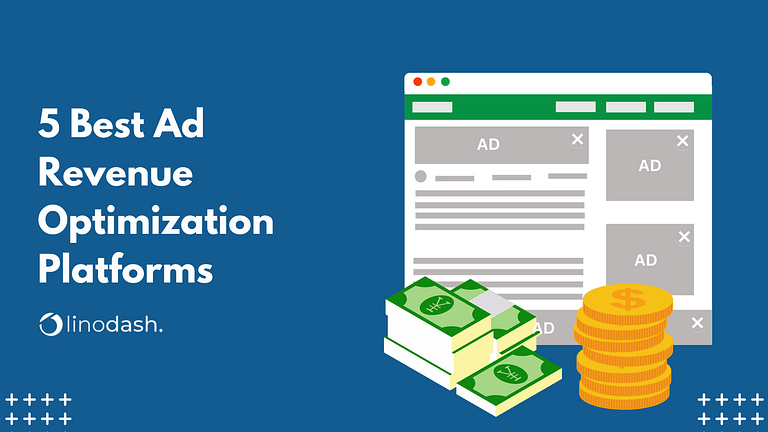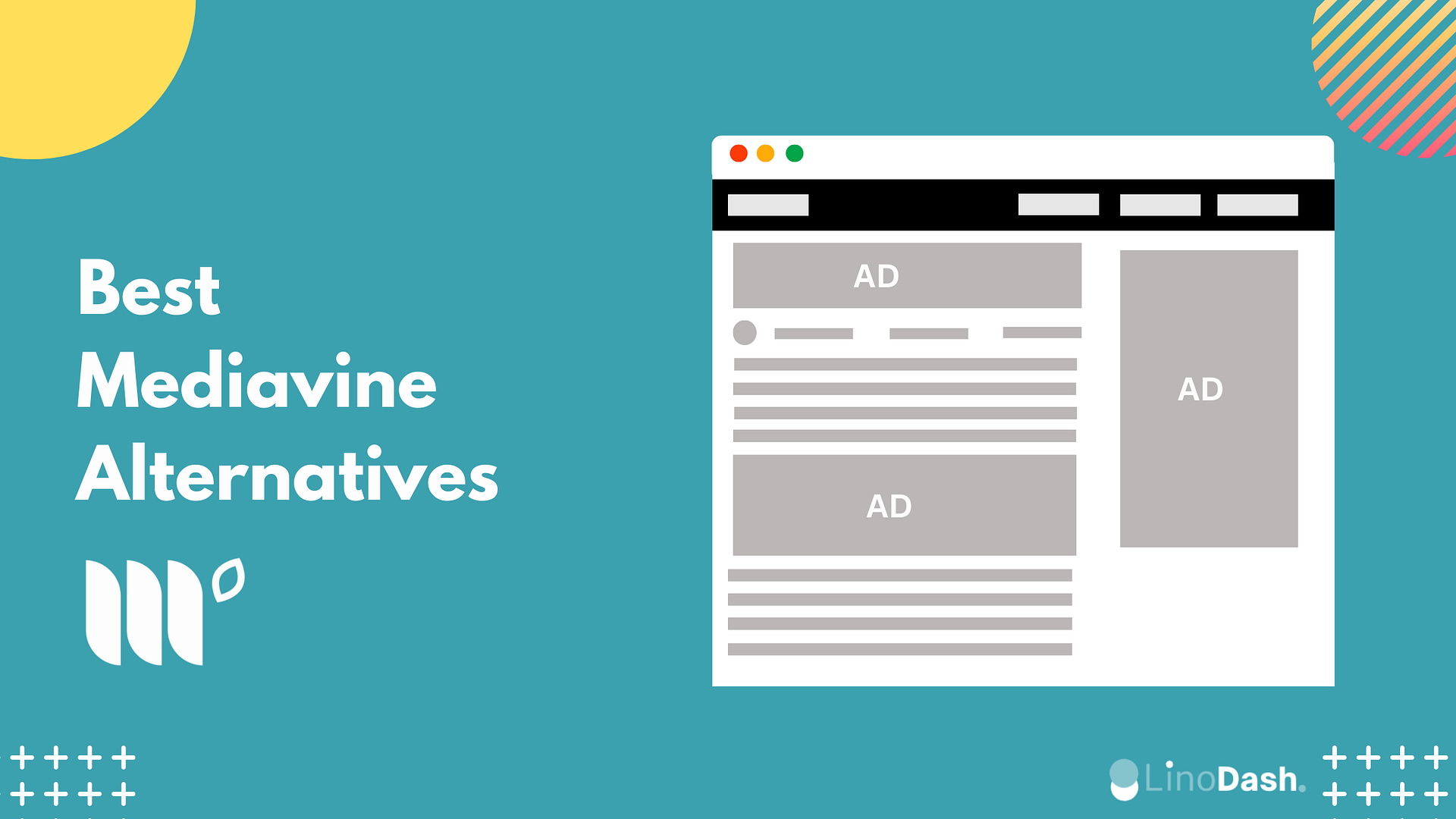
Mediavine has been the go-to ad management platform for bloggers looking to boost their ad revenue.
They have one of the most impressive RPMs on the market and a great support team.
Compared with an ad network like Adsense (that doesn’t offer any human support), you’re likely to see income growth when you switch to Mediavine.
Mediavine also offers one of the most competitive ad revenue-sharing models.
As a publisher, you get to keep 75%–85% of the total ad revenue earned, all depending on the ad impressions generated in the last 30 days.
However, as good as the ad platform sounds, Mediavine may not be the best ad network for every publisher.
They require your site to have at least 50,000 monthly sessions to qualify for their program.
For small blogs getting less traffic this requirement can be a limitation for them.
For example, if your blog receives 30,000 unique visitors per month, you will not qualify for their publisher program.
The best part is that there are Mediavine alternatives that you can use to monetize your blog.
So in this guide, I’ll show you:
- The best Mediavine alternatives for bloggers
- What you need to qualify for each Mediavine alternative’s publisher program
- And the pros and cons of each ad network
Let’s go.
Why Look For Mediavine Alternatives
There are specific reasons that can make you search for Mediavine alternatives.
Here are the common reasons:
- You’ve applied to Mediavine and got rejected.
- Your blog has not hit the Mediavine minimum traffic requirement of 50,000 sessions in the last 30 days.
- You don’t like the fact that you have to wait for 65 days to receive your first month ad revenue.
- Your blog is rapidly growing, and you want a better all-in-one ad management that’ll help boost your ad revenue.
- You don’t like the Mediavine branding on ads.
Best Mediavine alternatives
Here are my top five picks for the best Mediavine alternatives to choose from and monetize your website with ads.
- Ezoic: best for growing blogs
- Snigel: premium ad optimization partner
- Media.net: best contextual ads platform
- AdThrive: best for high-traffic blogs
- Monumetric: best for mid-sized blogs
- Adsense: best for new blogs
1. Ezoic
Best Mediavine Alternative For Growing Blogs
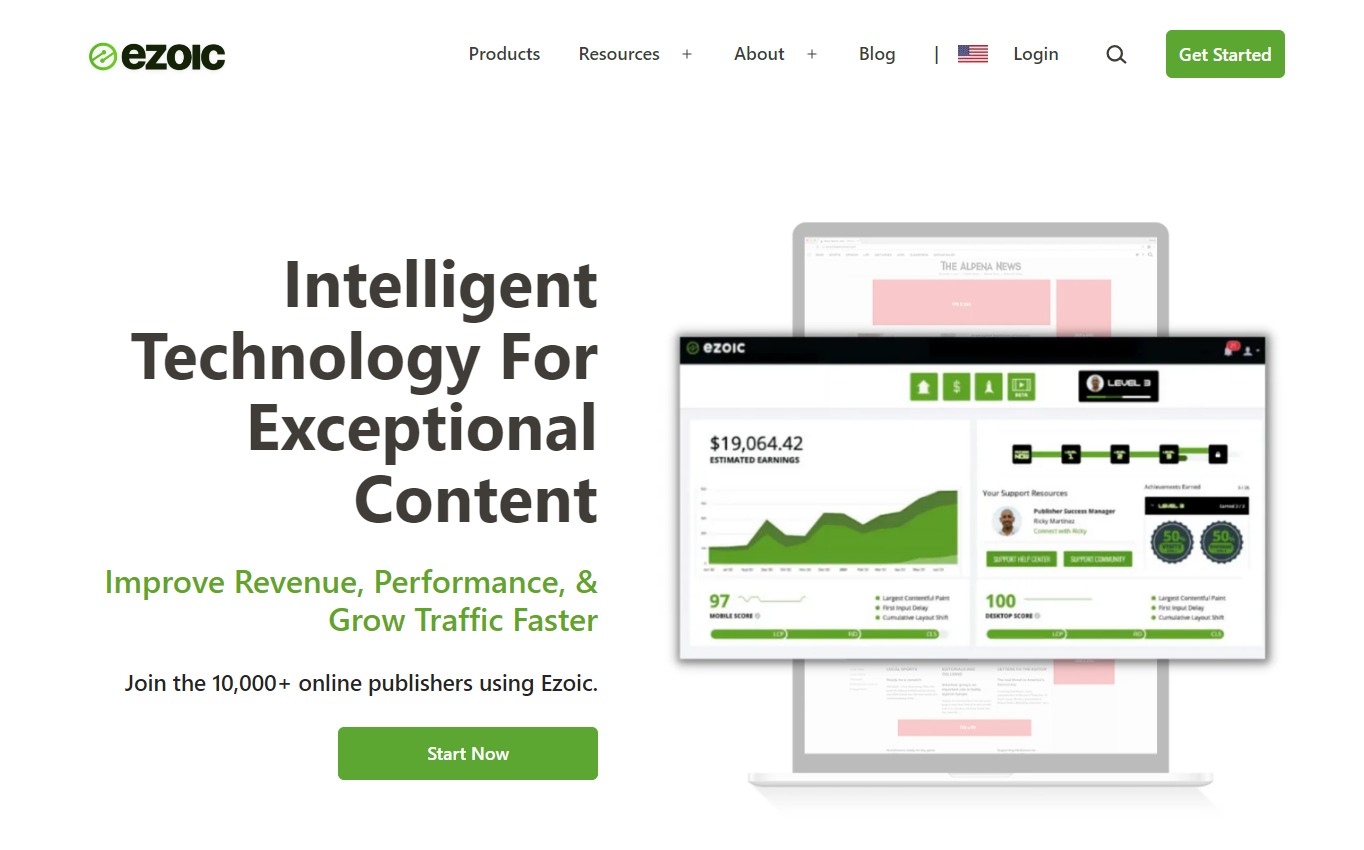
- Best for: Small & growing blogs
- Traffic Requirements: None
- Setup fees: None
- Payment Methods: Direct bank transfer (Payoneer), PayPal, Check, and Wise
- Biggest Pro: Full website control
- Biggest Con: Setup can be confusing
Ezoic is the best Mediavine alternative for small publishers looking to grow their ad revenue while keeping the user experience in mind.
The platform leverages the power of artificial intelligence (AI) and machine learning to optimize everything about your ads—their placements, sizes, and designs.
It’s like having a tech-savvy partner constantly testing different setups and learning from your visitors’ behavior, driving higher click-through rates and revenue. Talk about smart advertising ;).
But what sets Ezoic apart is its focus on small publishers. Unlike Mediavine, which mostly caters to the big shots with massive traffic, Ezoic supports websites with lower traffic volumes.
So, if your website doesn’t hit Mediavine’s high traffic thresholds yet, you can use Ezoic’s game-changing ad optimization technology to boost your ad revenue.
And here’s the icing on the cake—Ezoic puts you in the driver’s seat. Their user-friendly interface gives you full control over where your ads go and how they blend with your user experience.
You get to decide the density, location, and other settings that work best for your website. It’s all about finding that sweet spot where your revenue skyrockets while maintaining a smooth user experience.
Here is the set of tools you can access while using Ezoic to serve ads on your blog:
- Ad Tester tool: perhaps this is the most powerful Ezoic feature. This tool uses AI and machine learning to intelligently serve ads through multiple tests changing ad placements, networks, types, and sizes on your website to boost viewability, thereby increasing your ad revenue.
- Header bidding: This feature allows top ad exchanges and premium networks to compete for ad space on your websites to help you earn higher ad rates over time. You can access over 1,500+ advertisers and ad partners through Google AdExchange and AI ad inventory tailored to drive higher bids than your Adsense account.
- In-Depth tracking: Using Big Data Analytics, you can unlock insightful data about the performance of your website. This tool helps you evaluate your traffic value from different sources, allowing you to understand your audience’s behavior, which helps you produce quality and high-performing content.
- Faster website performance: Ezoic has a website speed optimization called Leap that allows you to improve your website performance. With Leap you can cache your web pages, migrate your DNS server to theirs, and even serve your website content and ads via the Ezoic Cloud CDN.
- Ezoic AI feature: This allows Ezoic to generate and test new placeholders on your pages automatically. The tool uses machine learning technology to assign and insert placeholders in spots on your website where they perform best.
Ezoic Publisher Requirements
Ezoic used to require all publishers to have at least 10,000 pageviews per month.
However, they ditched the requirement, and all sites can qualify for the Ezoic Access program without any traffic size requirement.
Nevertheless, they do have some requirements that your website must meet.
Here are Ezoic’s publisher’s requirements:
- Your site must have real and reliable website traffic sources.
- Your published content must be original, constructive, and engaging.
- Content must be published in an AdSense-supported language.
- Not publishing adult, dangerous, or derogatory content.
In short, Ezoic’s requirements are the same as Google Adsense’s. If you’re an approved Adsense user, that’s a direct ticket to getting approved by Ezoic.
Ezoic Pros
- You maintain full control of your website.
- Ads displayed are mobile friendly.
- Ezoic works with a ton of ad networks giving you more choices and flexibility to which ad network to work with.
- No setup fees or contract and you can leave Ezoic anytime you wish.
- In depth analytics that helps improve your site performance and generate more ad revenue.
Ezoic Cons
- The setup can be confusing and time consuming.
2. Snigel
Premium Ad Optimization Partner
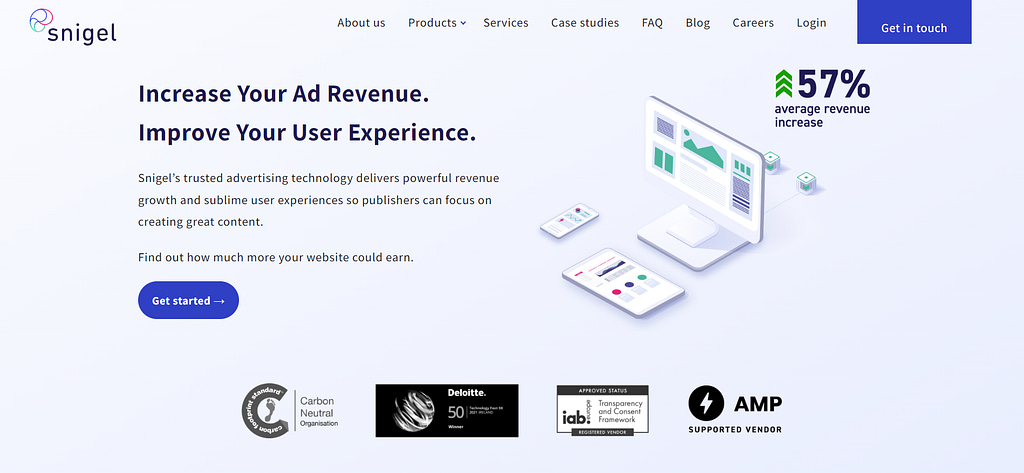
- Best for: Large blogs
- Traffic Requirements: 100,000 monthly pageviews
- Setup fees: None
- Payment Methods: Bank wire transfer
- Biggest Pro: Full-service ad management experts that do all the work for you
- Biggest Con: Advanced analytics available only via your account manager
Snigel is the brainchild of two ex-Google executives who saw AdSense’s limitations and decided to build a more open ad tech platform that was tailor-made to suit publishers’ needs.
It’s a full-service platform that includes a dedicated ad management expert who essentially becomes an extended member of your team.
They implement your ad monetization strategy, monitor performance, and provide ongoing optimizations customized to your needs.
Snigel offers two products to maximize revenue from ad inventory:
- AdEngine — Snigel’s header bidding solution that uses all major demand sources, SSPs, and ad exchanges to ensure the highest possible bid for ad space while ensuring the ads are relevant to your content
- AdStream — Snigel’s video ads solution enhances user engagement and time on site by presenting tailored, high-quality video ads. A great way to make extra revenue whether you already have video content or not (your ad expert can assist in creating content or provides syndicated content).
Additionally, Snigel gives you access to AdVantage, their real-time, interactive dashboard that lets you track the performance of your ads in real-time.
It doesn’t show you in-depth metrics like some other tools but that’s because your ad expert manages the optimization of your ads. And you can reach out to them at any time if you want a report.
Snigel gives you a simple deal: you keep 80% of the revenue, while they get the remaining 20%. It’s a transparent deal with no hidden costs, and you have the freedom to end the partnership at any time. Plus, it comes with a couple of additional perks:
- There’s no fixed contract period, meaning you’re free to move on whenever you want.
- You have ongoing access to personalized support from their team of ad experts.
Snigel is perfect for large-site content creators with busy schedules. It’s a top-notch service that maximizes your ad revenue and allows you to focus on what you do best – creating quality content, expanding your audience, and ensuring an exceptional user experience.
Snigel Publisher Requirements
Snigel wants to ensure a valuable network for both advertisers and publishers so your site needs to meet some quality standards before you can partner with them:
- Quality content and traffic: Your site needs to feature unique, high-quality content and attract traffic from reputable sources like referrals, SEO, or social media. They’re strict about partnering with sites that have fraudulent or bot-driven traffic.
- Page views: Your site should have a minimum of 100,000 monthly page views, with at least 20% coming from tier 1 geographical locations.
- Daily earnings: Your website needs to generate at least $50 USD per day.
- Original content: Your site’s content has to be original and free from any copyright issues.
It’s important to note that Snigel only partners with publishers where they are confident they can significantly improve their ad performance, which is why they can claim 20-40% higher profits.
Snigel Pros
- Full-service platform
- Real-time analytics and reporting
- Dedicated monetization expert
- Custom revenue sharing model
- Low impact on page speed and core web vitals
Snigel Cons
- Minimum requirement of 100k+ monthly visits
- Selective publisher partnerships
- Advanced analytics are available only through your account manager
3. Media.net
Best Contextual Ads Platform
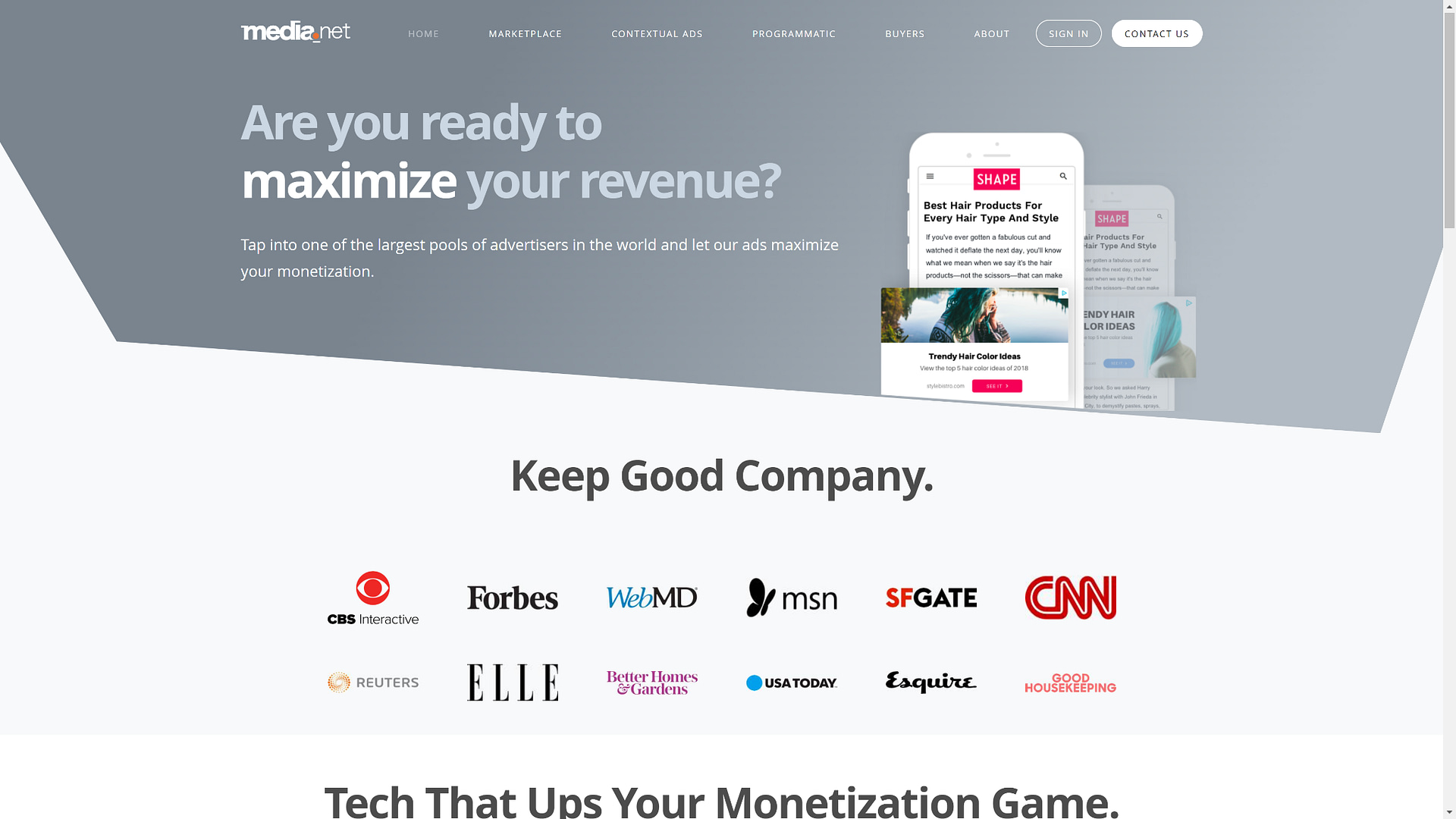
- Best for: Growing and Large Blogs
- Traffic requirements: Most of your traffic must be from the US, UK, and Canada
- Setup Fees: None
- Payment Methods: PayPal or Wire Transfer
- Biggest Pro: You will be assigned a personal account representative
- Biggest Con: There is no page-level reporting
With a reach of 100 million US desktop users, Media.net is one of the world’s biggest players in contextual advertising.
They’ve developed an amazing machine-learning technology called display-to-search (D2S) to serve their contextual ads.
The technology understands the search intent of the user and displays search-type ads with keywords relevant to that intent.
When visitors click on the keyword, they’re redirected to a page that resembles a search page filled with search ads.
Their contextual ads are effectively designed and appear as buttons with keywords that are hyper-relevant to whatever article they are on.
The ads are well designed to match the feel and appearance of your website thereby boosting
This allows your ad to blend harmoniously and match the feel and appearance of your site, thereby generating more clicks.
Their ad setup is a breeze.
You’re also assigned an account manager when you sign up to help you optimize your ads for performance and grow your ad revenue.
Media.net Publisher Requirements
Like most huge ad networks, Media.net doesn’t accept literally anyone. They have requirements that you need to meet in order to be accepted on their platform.
Here are the Media.net publisher requirements.
- High quality traffic from top tier countries like the US, UK and Canada.
- Your blog content needs to be high-quality, original and engaging.
- Your published content must be advertiser-friendly. It should not be substance-related.
- Lots of content published and updated regularly. No dormant blogs.
- Your website should have a modern and great design that’s easy to navigate
Media.net Pros
- Non-intrusive ads blend harmoniously with the website’s appearance.
- Customizable ads that allow you to match your content and website feel.
- A dedicated account manager that helps you boost your ad revenue.
- Can be used with other ad networks like Google Adsense.
Media.net Cons
- Only sites with traffic from top tier countries get approved.
- Lacks A/B testing tools making it harder to find optimization opportunities
4. AdThrive
Best Mediavine Alternative for High-Traffic Blogs
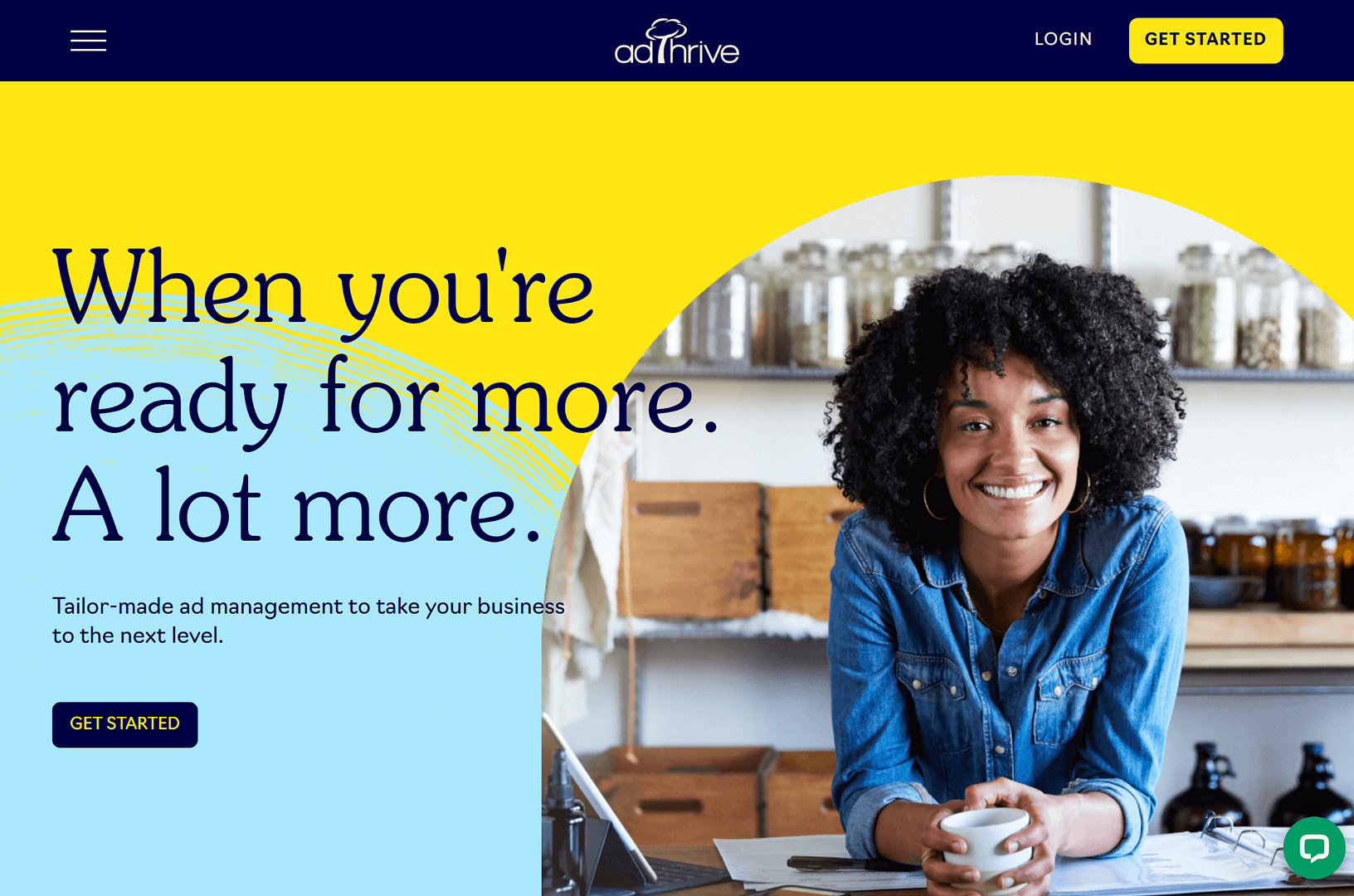
- Best for: Growing and Large Blogs
- Traffic requirements: 100,000 monthly pageviews on Google Analytics
- Setup Fees: No
- Payment Methods: Direct Deposit, PayPal, Paper Check, or Wire Transfer.
- Biggest Pro: High RPMs
- Biggest Con: High entry barrier
AdThrive is a full-service ad management network with over 35,000 independent publishers.
The ad network is known for its strictest approval process.
They only accept high-quality sites that get high-quality traffic of at least 100,000 monthly pageviews, as per Google Analytics.
But despite AdThrive’s strict approval process here’s what makes it the best Mediavine alternative.
High RPM.
In fact, they are so confident in this that they guarantee to increase your RPM by 20% within two weeks of switching to their ad network.
If they fail to deliver on the promise, they’ll pay you.
They also have a great revenue-sharing model. You receive 75% of the total ad revenue as a publisher, while AdThrive takes 25% to cover ad serving fees and other discrepancies.
Unlike Mediavine, which pays you on a NET 65 basis, AdThrive pays on a NET 45 basis.
Meaning that to receive your first paycheck from AdThrive, you’ll wait less than with Mediavine.
Like most high-end ad networks, their team handles everything during setup.
They’ll add an ads.txt file for you and even create custom ad placements on your site.
That means you don’t have to worry if you are not technically savvy.
Besides earning money through native ads with AdThrive, you can make money from video ads.
According to them, publishers that start monetizing video by implementing their guidelines report a 25–35% increase in RPM compared to those that do not.
Generally, AdThrive is the best Mediavine alternative for publications receiving vast amounts of traffic and looking to generate a handsome amount of ad revenue.
AdThrive Publisher Requirements
To start with, AdThrive is not for new sites with low traffic. In order to get accepted, your site needs to mark the following check boxes:
- A minimum of 100,000 monthly pageviews as per Google Analytics.
- A huge percentage of your traffic must come from top tier countries like the United States, United Kingdom, Canada, Australia and New Zealand
- You must publish high-quality, original and engaging content.
- Your site must not have previous advertising infringements with other ad networks like Google Adsense.
AdThrive Pros
- High RPM
- High ad share revenue of 75% to the publisher.
- Better payment schedule of 45 days after the end of a month
- Faster approval and onboarding process
- Your site is served with high quality ads
- High quality customer support
- Great dashboards and reporting
AdThrive Cons
- High entry barrier
- Reporting could be improved
5. Monumetric
Best Mediavine Alternative for Mid-Sized Blogs

- Best for: Mid-sized and large publishers
- Traffic requirements: a minimum of 10,000 pageviews per month
- Setup Fees: $99 one-time fee for the website with less than 80K pageviews per month
- Payment Methods: PayPal and bank transfer
- Biggest Pro: Great support team
- Biggest Con: Setup fee for small publishers
Monumetric started as a small ad network back in 2012 with the aim of providing bloggers with an ad solution that favored them.
That’s by ensuring that:
- Publishers get access to a great technology that connects them to the very best advertisers.
- Publishers get indepth analytics about their ad-revenue strategy.
- You can maximize your ad revenue while preserving the best user experience for your site.
- They can access quality support from a well-versed expert who’ll help them optimize their site for performance.
Over the last decade, Monumetric has grown into one of the best full-service ad management platforms with a pool of over 10,000 premium websites.
They work with you to help you choose the best ad layouts and technology that best fit your content and revenue goals.
Their team sets up the ads for you by embedding the scripts in the right places on your website. This allows you to concentrate on growing your blog’s traffic while the team ensures that the best ads are showing on your site.
Monumetric implements header bidding technology on every website. This ensures that your ad spaces on your blog generate maximum revenue.
They also have a unique pool of quality advertisers. This ensures that only high-quality and high-earning ads are shown on your site.
Perhaps the most interesting thing about Monumetric is their new and innovative ad video player called VOLT. It’s fast and does not affect page load times.
With VOLT, you can serve video ads on your pages while keeping latency lower than most video players.
Monumetric is also an ideal ad management platform due to their fast-loading ads. Unlike most ad networks, you’re not likely to face speed problems when running ads using Monumetric.
This helps you maintain a good balance between revenue optimization and a good user experience.
When you apply for Monumetric, you get a chance to pick from their four publisher programs that come with their own perks, provided you hit the required traffic requirements.
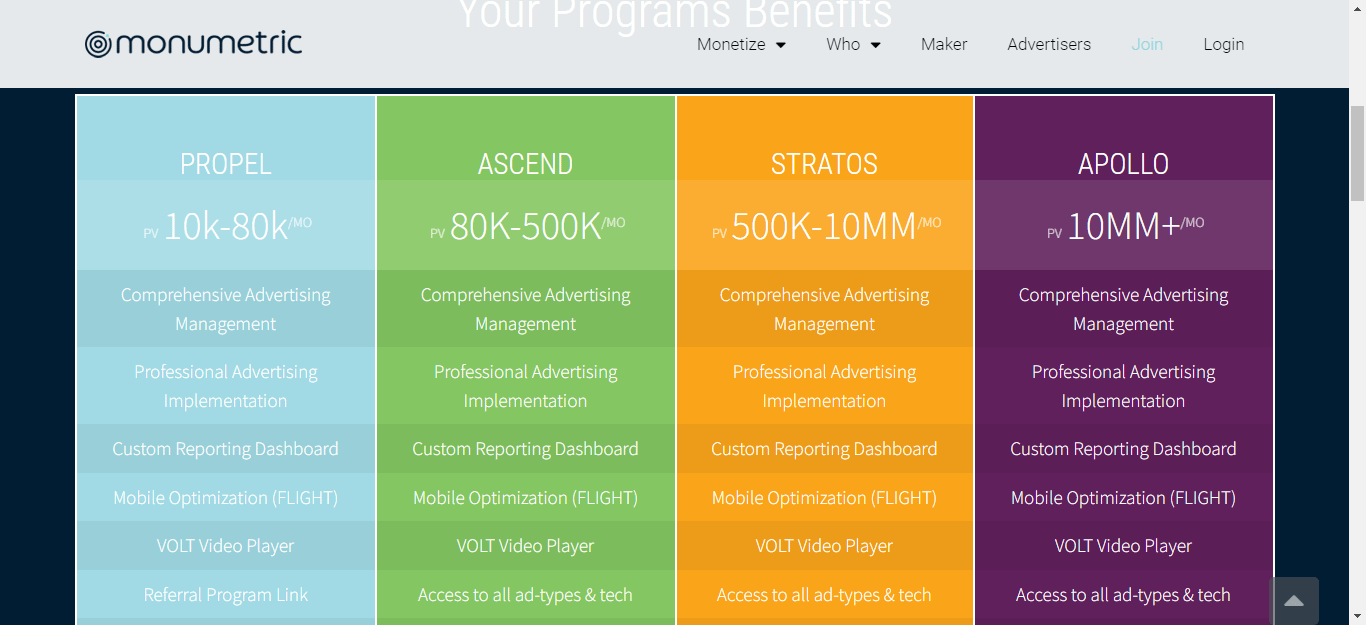
- Propel: 10k–80k per month
- Ascend: 80k–500k per month
- Stratos: 500k–10m per month
- Apollo: 10m plus per month
Monumetric Publishers Requirements
- Website needs to have a minimum of 10,000 monthly pageviews
- Majority of your traffic must be from UK, US, CA and AU
- The site must be in Good conditions by major ad platforms like Adsense.
- You must be willing to pay a $99 fee for ad set up if your site gets below 80k monthly pageviews.
Monumetric Pros
- Quality support
- Multiple revenue models depending on your traffic size
- A variety of ad units
- Fast loading video ads
- Quality metrics
Monumetric Cons
- An on net-60 payment schedule is quite a long duration to receive your first ad revenue
- A $99 setup fee for small publishers with less than 80k monthly pageviews
6. Google Adsense
Best for Brand New Blogs
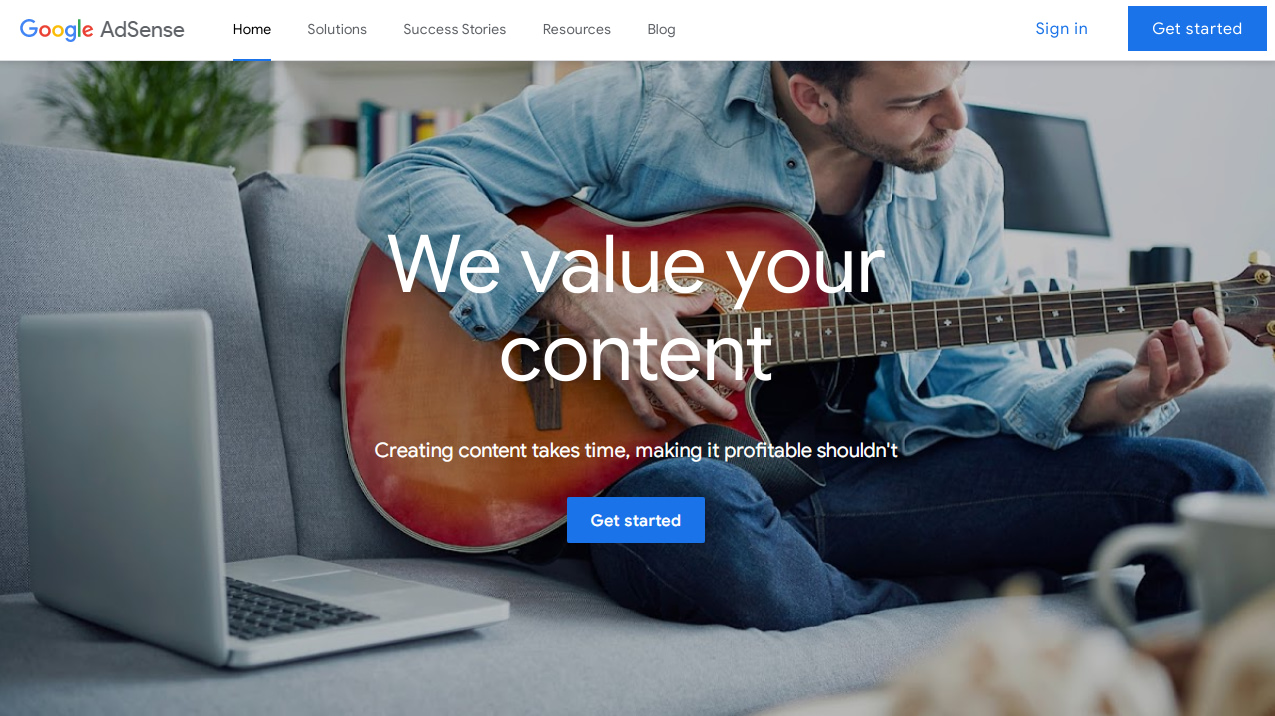
- Best for: brand new to growing blogs
- Traffic requirements: unspecified (but literally zero)
- Setup Fees: Free
- Payment Methods: Wire transfer or check
- Biggest Pro: Low entry barrier
- Biggest Con: Lacks human support
When it comes to monetizing your blog using ads, Adsense is the first platform that rings the bell for most new publishers.
Unlike most ad networks, the entry barrier for AdSense is quite low.
You just need to publish quality content that’s engaging, create a free account with them, and add a script of code.
When approved, Google Adsense will do the rest by displaying ads on your pages that are either relevant to your content or match the previous activity of the user on the web.
Google Adsense is a CPC-based ad network. That means that to make money from the ads, users must click on them.
However, that doesn’t mean that you can artificially manipulate clicks to earn more or invite your friends to click on the ads.
Google will quickly notice this, and they’re not forgiving when they close down your account.
Google Adsense also pays you based on ad impressions (CPM). However, this earning method is not available in the majority of ad types.
And considering that Google Adsense does not support auto-refresh functionality like Mediavine and Monumetric, it’s hard to make the most out of their cost per mille (CPM) model.
To serve ads on your site, Adsense uses the ad auction functionality to make sure that only the highest-paying ads show on your site.
Out of the total revenue generated, you’ll keep 68% and Google will keep the other 32%.
Google Adsense Publisher Requirements
- Great website navigation.
- Publish quality and original content
- You must be the genuine owner of the site
- Your site must have real traffic not bot traffic
Google Adense Pros
- Low entry barrier
- Adsense automatically places ads for you
- Easy to set up
- You can manage multiple sites under one account.
Google Adsense Cons
- Human support is not available
- You need to hit a threshold of atleast $100 to get paid
- Lacks advanced ads placement testing and optimization technology
Frequently Asked Questions
Is Mediavine better than AdSense?
Honestly speaking, Mediavine is way better than Adsense. That’s because you get access to a set of tools that help you optimize your ads for performance. Their team of experts works with you to help you earn the most from each ad unit. The Mediavine revenue share model is also higher than Adsense. As a publisher, you get to keep 75% of the total ad revenue with Mediavine, but with AdSense, the publisher makes 68% of the total revenue generated.
Is Ezoic better than Mediavine?
The choice between Ezoic and Mediavine depends on your website traffic and desired level of control. Ezoic is best for publishers with lower traffic seeking to boost ad revenue using advanced technology. Mediavine is suitable for larger publishers looking for a hands-off approach to ad optimization.
Which is the best Mediavine alternative for bloggers overall?
Monumetric is the best Mediavine alternative for mid-sized and large blogs. For new and growing blogs, Ezoic emerges as a clear winner.
How many views do you need for Mediavine?
You need at least 50,000 monthly sessions in the last 30 days to qualify for the Mediavine publisher program.
Conclusion
When it comes to monetizing a blog through ads, Mediavine is a reputable ad management platform. They have an excellent support team and are keen to provide a great user experience, which is why they’ve employed lazy load technology in all their ads.
Needless to say, Mediavine may not be the perfect ad network for small blogs. Which is where an ad platform like Ezoic comes in handy.
If you have a high-traffic blog, a full-service ad network like Monumetric can make a great Mediavine alternative. They have decent RPMs and outstanding customer support.
Now I would love to hear from you. Are you running ads on your blog? Which ad network are you using? Let me hear it in the comment section.

